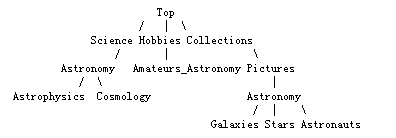官方文档 <a href='https://www.postgresql.org/docs/10/static/ltree.html' target=_blank'>https://www.postgresql.org/docs/10/static/ltree.html
ltree是俄罗斯Teodor Sigaev和Oleg Bartunov共同开发的PostgreSQL contrib扩展模块,它包含数据类型的实现、为树状结构组织的数据提供索引和查询。 http://www.sai.msu.su/~megera/postgres/gist/

关于GIST索引的一些介绍 https://yq.aliyun.com/articles/68244
一、安装ltree
CREATE EXTENSION IF NOT EXISTS ltree;
检查是否安装成功
select * from pg_extension where extname = 'ltree';

二、ltree的定义
- 标签是由一组字符数据(A-Za-z0-9_)组成的,每个标签最大256字节
- 标签的路径是由0个或多个点号分割(只能是.号),如 a.b.c.d
- 标签的总长度必须小于65kb,但最好维持在2kb以下
ltree提供两种数据类型
- ltree:存储标签路径
- lquery:表示用于匹配ltree值的类似正则表达式的模式。 一个简单的单词与路径中的标签匹配。 星号(*)匹配零个或多个标签。 例如:
foo 匹配确切的标签路径foo
*.foo.* 匹配包含标签foo的任何标签路径
*.foo 匹配最后一个标签为foo的任何标签路径
*标识可以量化,类似正则表达式
* {n}完全匹配n个标签
* {n,}匹配至少n个标签
* {n,m}匹配至少n个但不超过m个标签
* {,m}匹配最多m个标签 - 与* {0,m}相同
有几个修饰符可以放在lquery中非星形标签的末尾,以使其匹配的不仅仅是完全匹配:
@ 匹配大小写不敏感,例如@匹配A.
* 匹配任何带有此前缀的标签,例如foo *匹配foobar
% 匹配初始下划线分隔的单词
三、创建表&测试数据
CREATE TABLE test (path ltree);
INSERT INTO test VALUES ('Top');
INSERT INTO test VALUES ('Top.Science');
INSERT INTO test VALUES ('Top.Science.Astronomy');
INSERT INTO test VALUES ('Top.Science.Astronomy.Astrophysics');
INSERT INTO test VALUES ('Top.Science.Astronomy.Cosmology');
INSERT INTO test VALUES ('Top.Hobbies');
INSERT INTO test VALUES ('Top.Hobbies.Amateurs_Astronomy');
INSERT INTO test VALUES ('Top.Collections');
INSERT INTO test VALUES ('Top.Collections.Pictures');
INSERT INTO test VALUES ('Top.Collections.Pictures.Astronomy');
INSERT INTO test VALUES ('Top.Collections.Pictures.Astronomy.Stars');
INSERT INTO test VALUES ('Top.Collections.Pictures.Astronomy.Galaxies');
INSERT INTO test VALUES ('Top.Collections.Pictures.Astronomy.Astronauts');
四、安装GIST和BTREE索引
CREATE INDEX path_gist_idx ON test USING gist(path);
CREATE INDEX path_idx ON test USING btree(path);
五、操作符
| 操作符 | 返回类型 | 描述 |
|---|---|---|
| tree @> ltree | boolean | 左参数是右边的祖先(或平等)? |
| tree <@ ltree | boolean | 左参数是右(或相等)的后代? |
| tree ~ lquery | boolean | ltree是否匹配lquery? |
| query ~ ltree | boolean | ltree是否匹配lquery? |
| tree ? lquery[] | boolean | ltree是否匹配数组中的任何lquery? |
| query[] ? ltree | boolean | ltree是否匹配数组中的任何lquery? |
| tree @ ltxtquery | boolean | ltree是否匹配ltxtquery? |
| txtquery @ ltree | boolean | ltree是否匹配ltxtquery? |
| tree | ltree | |
| tree | text | |
| ext | ltree | |
| tree[] @> ltree | boolean | 数组是否包含ltree的祖先? |
| tree <@ ltree[] | boolean | 数组是否包含ltree的祖先? |
| tree[] <@ ltree | boolean | 数组是否包含ltree的后代? |
| tree @> ltree[] | boolean | 数组是否包含ltree的后代? |
| tree[] ~ lquery | boolean | 数组包含任何匹配lquery的路径? |
| query ~ ltree[] | boolean | 数组包含任何匹配lquery的路径? |
| tree[] ? lquery[] | boolean | ltree数组是否包含任何匹配任何lquery的路径? |
| query[] ? ltree[] | boolean | ltree数组是否包含任何匹配任何lquery的路径? |
| tree[] @ ltxtquery | boolean | 数组包含任何匹配ltxtquery的路径? |
| txtquery @ ltree[] | boolean | 数组包含任何匹配ltxtquery的路径? |
| tree[] ?@> ltree | ltree | 第一个数组条目,是ltree的祖先;如果没有则为NULL |
| tree[] ?<@ ltree | ltree | 第一个数组条目,是ltree的后代;如果没有则为NULL |
| tree[] ?~ lquery | ltree | 第一个匹配lquery的数组条目;如果没有则为NULL |
| tree[] ?@ ltxtquery | ltree | 第一个匹配ltxtquery的数组条目;如果没有则为NULL |
六、ltree函数库及示例
执行结果部分全部都亲测过,可以参考下。
| 函数名 | 返回类型 | 描述 | 示例 | 执行结果 |
|---|---|---|---|---|
| subltree(ltree, int start, int end) | ltree | ltree寻找子路径,下标从start到end的 (从0开始计数),下标越界会出错 |
select subltree('a.b.c.d', -1,0); select subltree('a.b.c.d', 0,1); select subltree('a.b.c.d', 2,3); select subltree('a.b.c.d', 4,5); select subltree('a.b.c.d', 2,1) |
invalid positions a c invalid positions invalid positions |
| subpath(ltree, int offset, int len) | ltree | ltree根据偏移量offset和len寻找子路径, 如果offset为负则从路径末端开始。 如果len为负数,则将许多标签留在路径的末尾, ps:len为负数的最好少用,有点奇怪 |
select subpath('a.b.c.d', 0,2); select subpath('a.b.c.d', 0,9); select subpath('a.b.c.d', 1,2); select subpath('a.b.c.d', 4,1); select subpath('a.b.c.d', -1,1); select subpath('a.b.c.d', -1,2); select subpath('a.b.c.d', -2,1); select subpath('a.b.c.d', -2,2); select subpath('a.b.c.d', -2,9); select subpath('a.b.c.d', -3,2); |
a,b a,b,c,d b,c invalid positions d d c c,d c,d b,c |
| subpath(ltree, int offset) | ltree | ltree根据偏移量offset寻的子路径, 延伸到路径的末尾,如果offset为负, 则子路径从路径末端开始。 |
select subpath('a.b.c.d', 0); select subpath('a.b.c.d', 1); select subpath('a.b.c.d', 2); select subpath('a.b.c.d', 3); select subpath('a.b.c.d', 4); select subpath('a.b.c.d', -1); select subpath('a.b.c.d', -2); select subpath('a.b.c.d', -3); select subpath('a.b.c.d', -4); select subpath('a.b.c.d', -5); |
a,b,c,d b,c,d c,d d invalid positions d c,d b,c,d a,b,c,d d |
| nlevel(ltree) | integer | 计算路径中标签数量 | select nlevel(''); select nlevel('a'); select nlevel('a.b'); select nlevel('a.b.c.d'); |
0 1 2 4 |
| index(ltree a, ltree b) | integer | 计算第一次在a中出现b的位置, 没找到返回-1 |
select index('a.b.c.d','c.d'); select index('a.b.c.d','a'); select index('a.b.c.d','a,b'); select index('a.b.c.d','e'); |
2 0 0 -1 |
| index(ltree a, ltree b, int offset) | integer | 计算在a中第一次出现b的位置, 从偏移处开始搜索; 负偏移意味着从路径末端开始 |
select index('a.b.c.d.e','c.d',1); select index('a.b.c.d.e','c.d',2); select index('a.b.c.d.e','c.d',3); select index('a.b.c.d.e','c.d',-1); select index('a.b.c.d.e','c.d',-2); select index('a.b.c.d.e','c.d',-3); |
2 2 -1 -1 -1 2 |
| text2ltree(text) | ltree | text 转 ltree | ||
| ltree2text(ltree) | text | ltree 转 text | ||
| lca(ltree, ltree, ...) | ltree | 路径最长的公共前缀部分 (最多支持8个ltree参数) |
select lca('a.b.c.d','a.b.c'); select lca('a.b.c.d','a.b.c','a.b'); select lca('a.b.c.d','c.d'); |
a.b a '' |
| lca(ltree[]) | ltree | 路径最长的公共前缀部分 | lca(array['1.2.2.3'::ltree,'1.2.3']) | 1.2 |
七、查询实例
1.查找Top.Science开始的path
SELECT path FROM test WHERE path <@ 'Top.Science';
path
------------------------------------
Top.Science
Top.Science.Astronomy
Top.Science.Astronomy.Astrophysics
Top.Science.Astronomy.Cosmology
(4 rows)
2.查找包含Astronomy的path
SELECT path FROM test WHERE path ~ '*.Astronomy.*';
path
-----------------------------------------------
Top.Science.Astronomy
Top.Science.Astronomy.Astrophysics
Top.Science.Astronomy.Cosmology
Top.Collections.Pictures.Astronomy
Top.Collections.Pictures.Astronomy.Stars
Top.Collections.Pictures.Astronomy.Galaxies
Top.Collections.Pictures.Astronomy.Astronauts
(7 rows)
3.查找包含Astronomy且前面节点不含pictures的path
SELECT path FROM test WHERE path ~ '*.!pictures@.*.Astronomy.*';
path
------------------------------------
Top.Science.Astronomy
Top.Science.Astronomy.Astrophysics
Top.Science.Astronomy.Cosmology
(3 rows)
4.查找第3个节点是'Astronomy'的,
注意此处最好加上nlevel(path) >2,因为可能有数据没有这么多节点
且where条件nlevel(path) >2要放在前面,postgresql的where条件是从前往后执行的
select path from test where nlevel(path) >2 and subpath(path,2,1) ='Astronomy';
path
------------------------------------
Top.Science.Astronomy
Top.Science.Astronomy.Astrophysics
Top.Science.Astronomy.Cosmology
(3 rows)
错误示范:
select path from test where subpath(path,2,1) ='Science' and nlevel(path) >1;
select path from test where subpath(path,2,1) ='Science';
------------------------------------
ERROR: invalid positions
SQL state: 22023
5.查到第二个节点是Science,注意看nlevel的变量
select path from test where nlevel(path) >1 and subpath(path,1,1) ='Science' ;
------------------------------------
Top.Science
Top.Science.Astronomy
Top.Science.Astronomy.Astrophysics
Top.Science.Astronomy.Cosmology
(4 rows)
select path from test where nlevel(path) >2 and subpath(path,1,1) ='Science' ;
------------------------------------
Top.Science.Astronomy
Top.Science.Astronomy.Astrophysics
Top.Science.Astronomy.Cosmology
(3 rows)
基本的使用案例就到此,其他的自己可以多去试试。ltree还是非常适合省市县级联这种关系